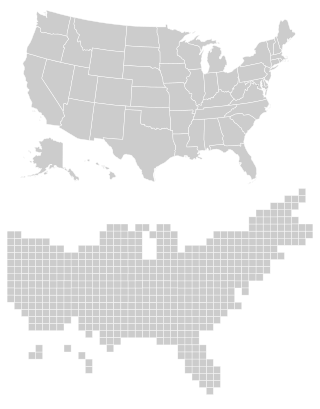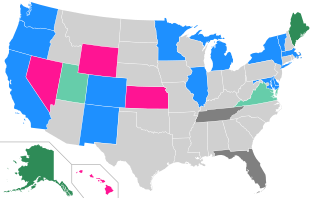Related Research Articles
Canada holds elections for legislatures or governments in several jurisdictions: for the federal (national) government, provincial and territorial governments, and municipal governments. Elections are also held for self-governing First Nations and for many other public and private organizations including corporations and trade unions. Municipal elections can also be held for both upper-tier and lower-tier governments.

In the politics of the United States, elections are held for government officials at the federal, state, and local levels. At the federal level, the nation's head of state, the president, is elected indirectly by the people of each state, through an Electoral College. Today, these electors almost always vote with the popular vote of their state. All members of the federal legislature, the Congress, are directly elected by the people of each state. There are many elected offices at state level, each state having at least an elective governor and legislature. There are also elected offices at the local level, in counties, cities, towns, townships, boroughs, and villages; as well as for special districts and school districts which may transcend county and municipal boundaries.

FairVote, formerly the Center for Voting and Democracy, is a 501(c)(3) organization that advocates electoral reform in the United States.
Instant-runoff voting (IRV) is a voting method used in single-seat elections with more than two candidates. Instead of voting only for a single candidate, voters in IRV elections can rank the candidates in order of preference. Ballots are initially counted for each elector's top choice, losing candidates are eliminated, and ballots for losing candidates are redistributed until one candidate is the top remaining choice of a majority of the voters. When the field is reduced to two, it has become an "instant runoff" that allows a comparison of the top two candidates head-to-head.

The National Popular Vote Interstate Compact (NPVIC) is an agreement among a group of U.S. states and the District of Columbia to award all their electoral votes to whichever presidential candidate wins the overall popular vote in the 50 states and the District of Columbia. The compact is designed to ensure that the candidate who receives the most votes nationwide is elected president, and it would come into effect only when it would guarantee that outcome. As of June 2022, it has been adopted by fifteen states and the District of Columbia. These states have 195 electoral votes, which is 36% of the Electoral College and 72% of the 270 votes needed to give the compact legal force.
Bills have been introduced in the US Congress on several occasions to amend the US Constitution to abolish or to reduce the power of the Electoral College and to provide for the direct popular election of the US president and vice president.
Electoral reform in Virginia refers to efforts to change the electoral system in the Commonwealth of Virginia. Virginia has undergone much electoral change since its settling in 1607, many of which were required by federal legislation. However, it remains a relatively conservative state in this respect compared to California and others which have experimented with various alternative systems.
Electoral reform in the United States refers to efforts to change American elections and the electoral system used in the United States.
Electoral reform in Alaska refers to efforts to change the voting laws in this U.S. state. U.S. Senator John McCain and other Republicans endorsed a referendum to implement Instant Runoff Voting, after the conservative vote split between the Republican candidate and the Alaskan Independence Party candidate, allowing a Democrat to win the governorship. However, the League of Women Voters opposed it, citing the principle of one man, one vote, and the measure was defeated. Another issue is whether Alaska will join the National Popular Vote Interstate Compact and designate its three electors to the candidate winning the nationwide popular vote, rather than the winner of the state's vote. SB 138, a bill to do just that, was introduced in 2007, but was not approved.
Electoral reform in Vermont has been an issue for decades. Changes in electoral practices have altered how election results represent the intent of Vermont voters and influenced debates in other states.

Electoral reform in California refers to efforts to change election and voting laws in the U.S. state of California.
Electoral reform in Florida refers to efforts to change the voting and election laws in the United States state of Florida.
Electoral reform in Minnesota refers to efforts to change the voting and election laws.
Electoral reform in Maryland refers to efforts, proposals and plans to change the election and voting laws in Maryland. In 2007, Maryland became the first U.S. state to join the National Popular Vote Interstate Compact. Bills have also been introduced to implement instant runoff voting (IRV) statewide, but they have failed, largely due to legislators' concerns about complicating the election process and causing technical problems similar to those encountered by Florida during the 2000 U.S. Presidential election. However, Takoma Park, Maryland adopted IRV in 2006 after it won 84% approval in an advisory ballot measure on November 8, 2005. Maryland is the home of the electoral reform organization Fairvote. In 2007, Maryland's Board of Elections Administrator, Linda Lamone, was quoted in Diebold advertising literature.
Electoral reform in North Carolina refers to efforts to change the voting and election laws in the Tar Heel State.
Electoral reform in New Mexico refers to efforts to change election and voting laws in this arid U.S. state.

Ranked-choice voting (RCV) is a ranked voting system used in some states and cities in the United States in which voters may prioritize (rank) their choice of candidates among many, and a procedure exists to count lower ranked candidates if and after higher ranked candidates have been eliminated, usually in a succession of counting rounds. In practice, there are several ways this can be implemented and variations exist; instant-runoff voting (IRV) and single transferable vote (STV) are the general types of ranked-choice voting systems used in the United States.
Instant-runoff voting (IRV) is a type of ranked preferential voting method. It uses a majority voting rule in single-winner elections where there are more than two candidates. It is commonly referred to as ranked-choice voting (RCV) in the United States, preferential voting in Australia, where it has seen the widest adoption; in the United Kingdom, it is generally called alternative vote (AV), whereas in some other countries it is referred to as the single transferable vote, which usually means only its multi-winner variant. All these names are often used inconsistently.

The election of the president and the vice president of the United States is an indirect election in which citizens of the United States who are registered to vote in one of the fifty U.S. states or in Washington, D.C., cast ballots not directly for those offices, but instead for members of the Electoral College. These electors then cast direct votes, known as electoral votes, for president, and for vice president. The candidate who receives an absolute majority of electoral votes is then elected to that office. If no candidate receives an absolute majority of the votes for president, the House of Representatives elects the president; likewise if no one receives an absolute majority of the votes for vice president, then the Senate elects the vice president.
Electoral reform in Oregon refers to efforts to change election and voting laws in the West Coast state of Oregon.
References
- ↑ IRV Washington
- ↑ Instant runoff voting: speaking to voter needs, Krist Novoselic, Seattle Times, Jan. 3, 2007.
- ↑ Bowles for President Archived 2007-10-12 at the Wayback Machine .
- ↑ Felony Disenfranchisement Laws Archived 2009-06-29 at the Library of Congress Web Archives, Brennan Center.
- ↑ "SB5599, 2009". Washington State Legislature. 2009. Retrieved 2009-01-23.